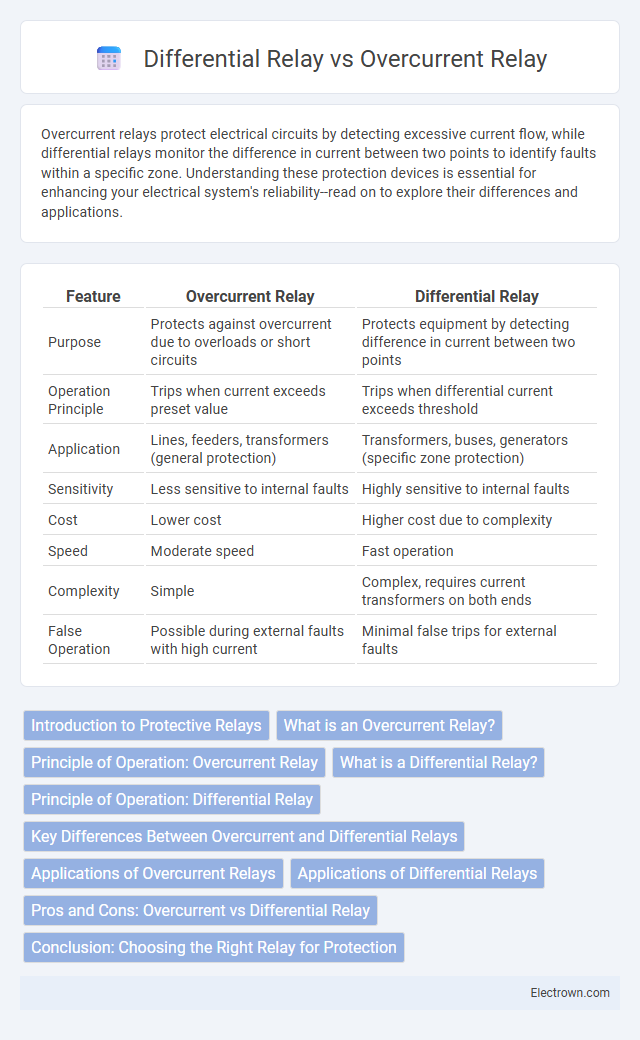Overcurrent relays protect electrical circuits by detecting excessive current flow, while differential relays monitor the difference in current between two points to identify faults within a specific zone. Understanding these protection devices is essential for enhancing your electrical system's reliability--read on to explore their differences and applications.
Table of Comparison
| Feature | Overcurrent Relay | Differential Relay |
|---|---|---|
| Purpose | Protects against overcurrent due to overloads or short circuits | Protects equipment by detecting difference in current between two points |
| Operation Principle | Trips when current exceeds preset value | Trips when differential current exceeds threshold |
| Application | Lines, feeders, transformers (general protection) | Transformers, buses, generators (specific zone protection) |
| Sensitivity | Less sensitive to internal faults | Highly sensitive to internal faults |
| Cost | Lower cost | Higher cost due to complexity |
| Speed | Moderate speed | Fast operation |
| Complexity | Simple | Complex, requires current transformers on both ends |
| False Operation | Possible during external faults with high current | Minimal false trips for external faults |
Introduction to Protective Relays
Protective relays play a critical role in electrical power systems by detecting faults and initiating circuit breaker operations to prevent damage. Overcurrent relays respond to abnormal current levels exceeding preset thresholds, effectively protecting lines and transformers from overloads and short circuits. Differential relays compare currents entering and leaving a protected zone, offering precise fault detection within equipment such as generators, transformers, and busbars to enhance system reliability.
What is an Overcurrent Relay?
An Overcurrent Relay is a protective device designed to trip a circuit when the current exceeds a preset value, preventing damage caused by excessive current flow. It detects faults like short circuits and overloads by continuously monitoring current levels and activating the circuit breaker during abnormal conditions. Your electrical systems rely on overcurrent relays to ensure safety and minimize equipment damage by promptly interrupting fault currents.
Principle of Operation: Overcurrent Relay
Overcurrent relays operate based on the detection of excessive current flowing through a circuit, which exceeds a preset threshold value. These relays monitor the magnitude of current continuously and actuate the trip mechanism when the current surpasses the set point, protecting electrical equipment from damage due to overloads or short circuits. The principle relies on overcurrent detection using either instantaneous or time-delay characteristics to coordinate with other protective devices.
What is a Differential Relay?
A differential relay is a protective device designed to detect differences in current between two or more points in an electrical system, indicating faults such as short circuits or winding failures. It operates by comparing input currents on either side of equipment like transformers or generators, tripping the circuit breaker if the current difference exceeds a preset threshold. Differential relays provide high sensitivity and fast fault detection, making them essential for protecting critical electrical assets.
Principle of Operation: Differential Relay
The principle of operation of a differential relay is based on comparing the current entering and leaving a protected zone to detect any imbalance caused by faults. It measures the difference between two or more currents and trips the circuit if the difference exceeds a preset threshold, indicating an internal fault. Your system's reliability is enhanced by this precise fault detection method, minimizing damage and outage duration.
Key Differences Between Overcurrent and Differential Relays
Overcurrent relays detect fault currents by measuring the magnitude of current exceeding a preset threshold, primarily protecting circuits against overloads and short circuits. Differential relays compare current entering and leaving a protected zone, identifying faults through the difference in current and providing precise protection for transformers, generators, and motors. Your choice depends on application needs: overcurrent relays offer broad fault coverage, while differential relays deliver high sensitivity and accuracy for internal fault detection.
Applications of Overcurrent Relays
Overcurrent relays are primarily used for protecting electrical power systems against excessive current caused by overloads or short circuits, making them essential in distribution networks, transformers, feeders, and busbars. These relays detect current levels exceeding preset thresholds and initiate circuit breaker trips to prevent equipment damage and ensure system stability. Widely implemented in industrial plants, substations, and transmission lines, overcurrent relays offer reliable, cost-effective protection with simple settings for fault detection.
Applications of Differential Relays
Differential relays are primarily used for protecting electrical equipment such as transformers, generators, and busbars by detecting internal faults through comparison of current entering and leaving the protected zone. They offer high sensitivity and selectivity by measuring the difference between two or more current inputs, making them ideal for detecting phase-to-phase and phase-to-ground faults within confined zones. These relays are crucial in safeguarding critical infrastructure where precise fault detection minimizes damage and enhances system reliability.
Pros and Cons: Overcurrent vs Differential Relay
Overcurrent relays are valued for their simplicity, cost-effectiveness, and reliability in detecting faults based on current magnitude, making them suitable for general protection schemes. Differential relays offer high sensitivity and selectivity by comparing currents at different points, enabling precise fault location but require complex setup and higher costs. Your choice depends on balancing the need for accuracy and protection speed against installation complexity and budget.
Conclusion: Choosing the Right Relay for Protection
Overcurrent relays provide protection by detecting excessive current flow indicative of overloads or short circuits, making them ideal for general fault detection and simpler systems. Differential relays offer precise protection by comparing current differences between two points, ensuring sensitive and selective fault isolation in complex or critical equipment. Your choice should depend on the specific protection needs, system complexity, and the importance of fault selectivity and sensitivity.
Overcurrent Relay vs Differential Relay Infographic

 electrown.com
electrown.com